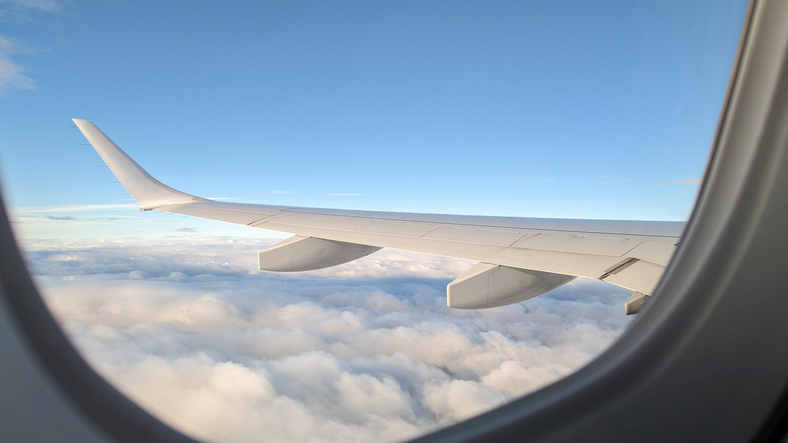The golden era of flying is over: rowdy passengers, greedy airlines and miserable airports make travelling nowadays rather grim. The Air India crash in June, which claimed the lives of all but one of the 242 people aboard and 19 others on the ground, has also made many passengers rather jittery, not least because questions remain over what caused the fatal crash. But despite it all, I still love flying.
Almost no one on board took the slightest notice. They were too busy watching their devices
From the very first time I flew to Düsseldorf in the late 1960s for a Christmas stay with friends, I was hooked. In the years since, I’ve flown many times – across Africa, Asia, Europe and North America – but still to this day I’m entranced by the experience of being up there among the clouds, or – best of all – in a clear sky and able to watch the world beneath. I have lost count of the times I have crossed the Alps en route to and from southern Europe. But seeing the mountains from above, even if you can only just detect the highest peaks protruding from thick cloud, never ceases to thrill.
From airplane windows, I’ve glimpsed the Northern Lights from above (over the Canadian Maritimes), wondered at the moon reflected in Nile, and luxuriated in a film-like perspective on the Tarn Gorges from an Air France route that nowadays most of us would do by train.
The prospect of seeing such wonderful views is one reason, along with not losing out on sleep, why I will go out of my way to travel by day rather than taking the night flights that tour operators seem wedded to (as perhaps saving a night in a hotel room and squeezing a complicated route into a standard 14 days). On flights that I have taken by day but are more commonly taken at night, I have been treated to panoramic views of the Ganges Delta, in bright blues and greens; Lake Baikal with its contours exactly as they appear on the map amid the forested expanses of Siberia, and the deep red and orange deserts of the US South-West.
It is a privilege to have seen such wonders of the world. I hope to see more – and, with apologies to Greta Thunberg, the only way you are going to see them is from a plane. But those chances may be diminishing, because I must also report a regrettable new trend. It would appear that my enthusiasm for seeing what can be seen from a plane window is shared by ever fewer of my fellow passengers.
I obeyed, but never liked, the request from the crew to lower the blinds for a few hours of sleep, whether or not it was dark outside – but fair enough, there are time zones to be crossed. I might sneak a little look under the blind from time to time, but enclosure always had a beginning and an end.
If you still think this is the rule, well, I have (bad) news for you. On recent internal flights in the US, most passengers pulled the blinds down the moment they got on and left them there until after landing, when the engines were switched off. And there were no announcements about opening the windows for take-off and no objections from the crew.
There was a glorious view of Key West when the clouds suddenly parted as the plane approached its landing. Almost no one on board took the slightest notice. They were too busy watching whatever they were watching on their ‘devices’ – the virtual world apparently having more appeal than the glories of the real world unfolding below. Fewer pilots seem keen on pointing out the wonders of the world far below. On my recent flight to Washington DC, the pilot pointed out an unusually clear view of the Manhattan skyline from the left side of the aircraft. Alas and alack, I was on the right.
As we disembarked, I asked an attendant about whether the policy on blinds had changed, and she said it had become increasingly common for passengers to keep them down. Preferences, she said, seemed to have changed. Or, perhaps, as I rather suspect, the ‘device’ rules, and it requires gloom to perform at its best.
At this point, I should probably make clear that I am well aware of the downsides of flying: all the hassle at the airport, the mysteries of the baggage allowance, the discomfort of the seats, the plastic food, the bawling baby, the fidgety child, basically anyone in the next seat. Not to mention, of course, CO2. But there is only one downside that for me comes anywhere near competing with the view.
If you are returning to London and it’s your lucky day, the skies will be clear, your plane won’t be stacked, and the pilot will delight in showing you a bird’s eye view of the local landmarks, from the Thames Barrier, via Tower Bridge, St Paul’s and the Houses of Parliament. Which is when my qualms begin.
Having lived in central or south-west London for almost all the many years I have spent in London, I can practically pick out the streets and even the individual housing blocks from the air. And I know that, if I were at that very moment hoping for a quiet morning or evening in, my plane would be one of those lining up for its final descent into London Heathrow and disturbing my peace. So, yes, I know this downside all too well; and yes, I think the hours of night flights over urban areas should be drastically cut.
But the exhilaration that comes from being able to see so many of the world’s wonders from many thousands of feet up should be lauded, not condemned. And, thanks to mass air travel, it is an experience that is no longer restricted to the professionals or the elite.






Comments